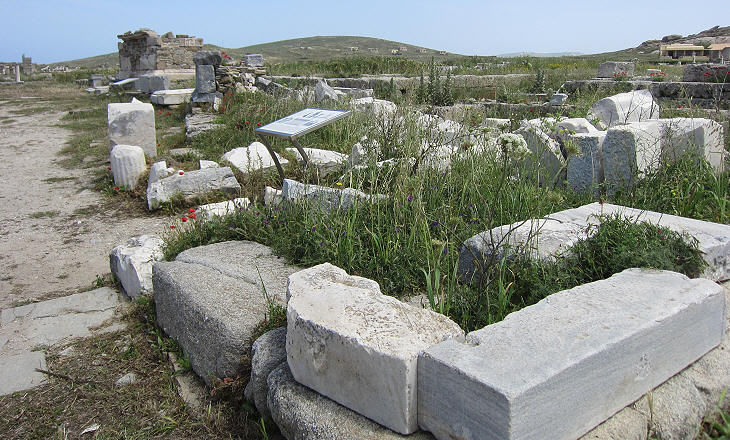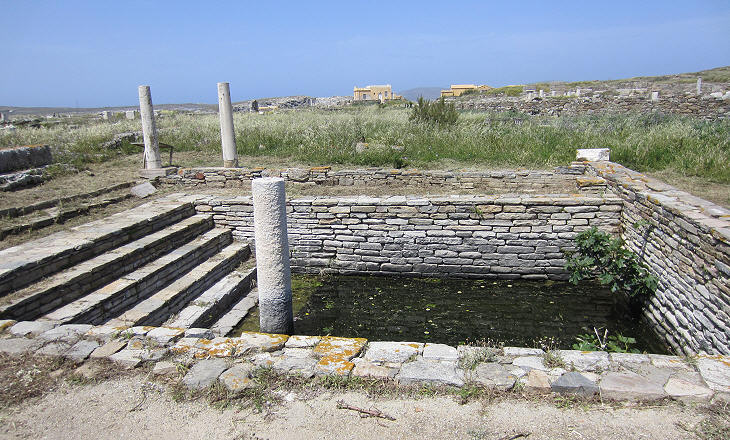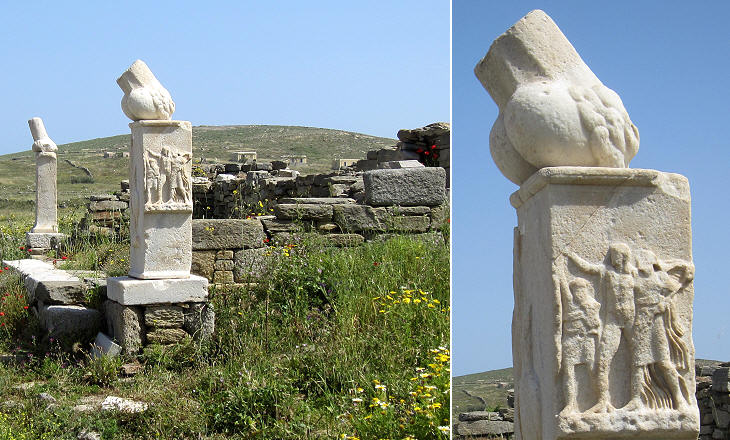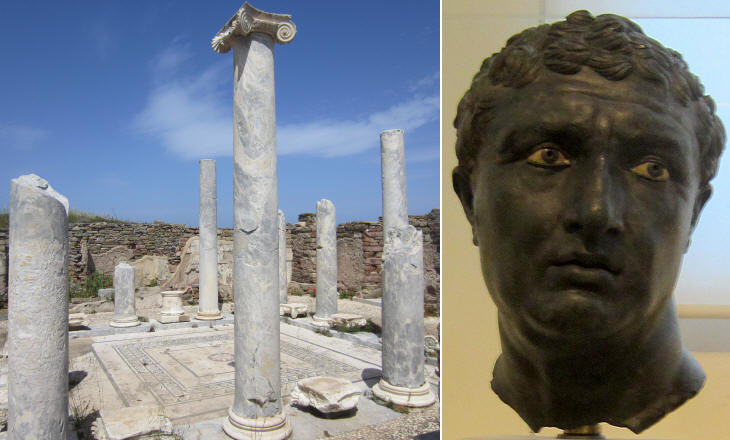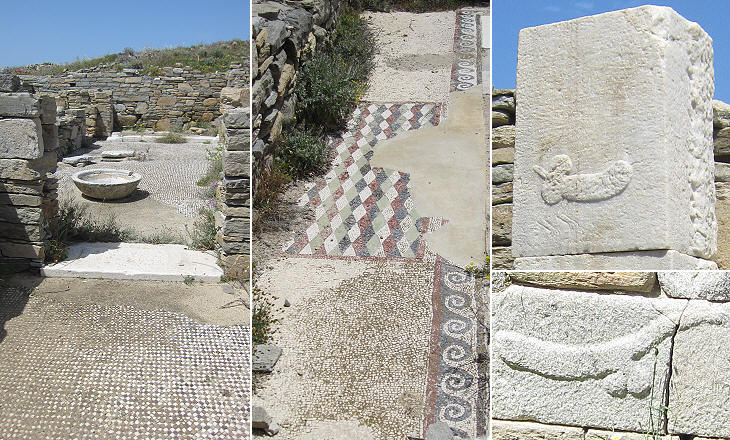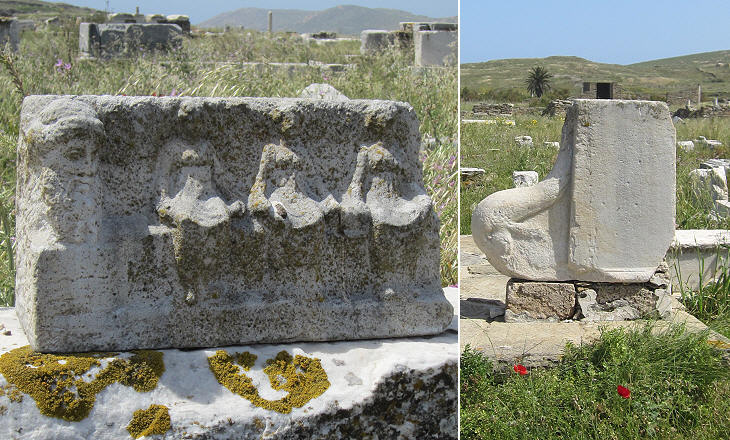  What's New! Detailed Sitemap All images © by Roberto Piperno, owner of the domain. Write to romapip@quipo.it. Text edited by Rosamie Moore. Page added in August 2011. |
 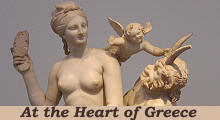 - Delos - The Sanctuaries - Delos - The Sanctuaries(Venus and Pan, now in Athens) The Homeric Hymns are 34 anonymous poems in the epic meter, the earliest of which may have been written roughly contemporaneously with Homer and Hesiod. The Hymn to Delian Apollo describes how Leto, in travail with Apollo, bore her son at Delos. "Among those who are in Crete, and in the township of Athens, and in the isles of Aegina and Euboea, famous for ships, in Aegae and Eiresiae and Peparethus near the sea, in Thracian Athos and Pelion's towering heights and Thracian Samos and the shady hills of Ida, in Scyros and Phocaea and the high hill of Autocane and far-lying Imbros and smouldering Lemnos and rich Lesbos, home of Macar, the son of Aeolus, and Chios, brightest of all the isles that lie in the sea, and craggy Mimas and the heights of Corycus and gleaming Claros and the sheer hill of Aesagea and watered Samos and the steep heights of Mycale, in Miletus and Cos, the city of Meropian men, and steep Cnidos and windy Carpathos, in Naxos and Paros and rocky Rhenaea -- so far roamed Leto in travail with the god who shoots afar, to see if any land would be willing to make a dwelling for her son. But they greatly trembled and feared, and none, not even the richest of them, dared receive Phoebus, until queenly Leto set foot on Delos and uttered winged words and asked her." (vv 30-50 - Translation by Hugh G. Evelyn-White)
"Delos, if you would be willing to be the abode of my son Phoebus Apollo and make him a rich temple; for no other will touch you, as you will find: and I think you will never be rich in oxen and sheep, nor bear vintage nor yet produce plants abundantly. But if you have the temple of far-shooting Apollo, all men will bring you hecatombs and gather here, and incessant savour of rich sacrifice will always arise, and you will feed those who dwell in you from the hand of strangers; for truly your own soil is not rich." (ditto - vv 51-61) "So spake Leto. And Delos rejoiced and answered and said: 'Leto, most glorious daughter of great Coeus, joyfully would I receive your child the far-shooting lord." (ditto - vv 62-65) "So said Delos. And Leto sware the great oath of the gods: 'Now hear this, Earth and wide Heaven above, and dropping water of Styx (this is the strongest and most awful oath for the blessed gods), surely Phoebus shall have here his fragrant altar and precinct, and you he shall honour above all.' Now when Leto had sworn and ended her oath, Delos was very glad at the birth of the far-shooting lord. But Leto was racked nine days and nine nights with pangs beyond wont."(ditto - vv 83-93)
The promise of Leto was not in vain; the first temple to Apollo has been identified by archaeologists very near one of the two adjoining harbours of Delos; it was built by the inhabitants of Naxos in the VIth century BC; at the same time the Naxians built (but never completed) a great temple to Apollo on their own island which was oriented towards Delos. The choice of Delos as a site for a great sanctuary was probably due to its central position: it was surrounded by five large islands (in clockwise order starting from the north): Tinos, Mykonos, Naxos, Paros and Syros. The islands were called Cyclades because they formed a circle around Delos. Naxos was the largest and most prosperous of these islands and it was the hegemonic power in this part of the Aegean Sea until 490 BC when the Persians attacked the island and destroyed its main towns.
The Naxians erected a gigantic statue of Apollo, the so-called Colossus of the Naxians; the marble was probably quarried on Paros; it portrayed a standing naked young man with an advanced leg; this type of statue is called kouroi (young man); because the earliest examples of kouroi were found at Delos initially these statues were all thought to represent Apollo, but eventually kouroi representing other gods or athletes were found at various Greek locations.
In 1420 Bondelmonte, an Italian traveller, reported having seen a gigantic statue on the ground at Delos; a drawing by Dutch traveller Seger de Vries (you may wish to see it in a separate window) indicates that in 1673 the statue was broken into two major pieces: the head with the torso and the waist with the thighs. The remaining pieces do not stand on the original pedestal of the statue, but a few yards away nearer to the sea; it is thought that the statue was sawn between 1420 and 1673 and an attempt was made to carry it away.
Leto delivered Apollo on Mount Cynthus, the hill at the southern end of Delos; she did so between an olive-tree and a date-palm; in the Vth century a (lost) bronze palm was erected behind the Colossus of the Naxians and in its memory archaeologists have planted a palm at the centre of a pond which housed swans and geese sacred to Apollo.
The Naxians built a terrace on the western side of the Sacred Pond; a series of marble lions guarded the entrance to a sanctuary; it is thought that they were at least nine; the remaining five have been replaced by copies (originals in the small museum of Delos); they recall the animals guarding the alleys of Egyptian Karnak, while their stylized design and in particular their open mouth is unusual in Greek art and indicates an Asian influence (you may wish to see the lions guarding a gate of Hittite Hattusa).
Tinos and Mykonos were Venetian possessions until 1715 and a few years before the Venetians were forced to surrender the islands to the Ottomans one of the lions was removed from Delos and shipped to Venice to guard the entrance to the Arsenal of the city. The Venetians however were unhappy about the rough design of the head and they replaced it with a modern one which, unlike the original, is more composed and keeps its mouth shut.
Three temples to Apollo in a row were built behind that of the Naxians; the oldest one housed the treasury of the Delian League, an alliance of Greek cities against the Persian threat; profiting from the decline of Naxos, the Athenians gained control of the sanctuary and in 426 BC they decreed that to preserve its purity births and deaths were not allowed to occur on Delos, a decision which explains why archaeologists have not found funerary monuments on the island; the Athenians eventually transferred the treasury from Delos to their own city.
The construction of the main temple to Apollo was started in the Vth century, but it was completed only two centuries later; the Athenians revived old ceremonies (Delian Festivals) which took place every four years and which initially were only meant to worship Apollo; minor celebrations occurred on a yearly basis and the Athenians sent their representatives on a ship, which was that used by Theseus on his voyage to Crete to slay the Minotaur.
Artemis was the twin sister of Apollo, but according to most accounts she was not born with him at Delos, but at an earlier time on Ortigya, the island to the west of Delos; the nature and deeds of Artemis were very similar to those of Apollo. Delos was placed at the centre of the Greek world, the boundaries of which included the Asian shores of the Aegean Sea; while the European part of this world saw the prevalence of male deities, the Asian one was more linked to the ancestral cult of Mother Earth, so Apollo was honoured at Delphi in continental Greece and Artemis and Leto were honoured respectively at Ephesus and Letoon in today's Turkey.
The Minoan Fountain was a public well built by the Cretans and one of the oldest places on Delos. It indicates that the worship of Delian Apollo reached that island at the southern border of the Greek world at a very early stage; similar to other very old monuments of Delos, the fountain was redesigned at a later time and it was eventually incorporated into a private house.
The myth of Apollo goes back to the earliest development of the Greek religion, while that of Dionysus, which is associated with the spread of the growing of grapes, acquired importance only at a later time; for many aspects Dionysus was identified with Apollo and the owners of two houses in the Theatre's Quarter chose to have mosaics portraying this more modern god rather than Apollo. In ca 300 BC a small temple was dedicated to Dionysus at a remarkable distance from the sanctuaries to Apollo and Artemis; the temple was built by a private citizen to celebrate his success in a theatrical performance. Dionysus had a rather effeminate appearance, nonetheless he was associated with uncontrolled excitement (also of a sexual nature) and this explains why two gigantic phalli were placed at the sides of the god's statue.
In the IVth century BC King Philip II of Macedonia established the hegemony of his nation over most of the Greek city-states of the mainland including Athens; Delos profited by the situation to free itself from the Athenian patronage and it became the centre of a confederation of islands; the Macedonian kings respected the sanctuary which they supported by making contributions including the construction by King Philip V of a portico along the street which linked the commercial harbour to the area of the sanctuaries.
In 215 King Philip V of Macedonia sided with the Carthaginians during the Second Punic War; it was a very unwise decision because the Romans landed in Albania and from there moved southwards and defeated the Macedonians. The war marked the beginning of the Roman hegemony over Greece which was helped by the alliance the Romans established with the Kings of Pergamum and with the city of Rhodes. Relations with the latter turned sour when Rhodes became weary of the growing power of the Romans in the region. As a reaction the Romans favoured the development of Delos as a trade centre, in particular of slaves, thus undermining the economy of Rhodes; Delian Festivals lost their religious connotation to become a sort of international fair which attracted merchants from all corners of the Mediterranean Sea. Eventually the Cyclades were incorporated into the Province of Asia which was established in 129 BC.
The stable presence of many Roman merchants at Delos led to the construction of temples which reflected their religious background; the Altar of the Lares Compitales was erected in a large square adjoining the commercial harbour; Lares Compitales were the protectors of crossroads and by extension of travellers and merchants; after a religious reform promoted by Emperor Augustus they were also called Lares Augusti. Mercury was the patron of commerce, a characteristic which was not so evident in Hermes, his Greek counterpart.
Delos had two residential quarters: one was located in the southern part of the island around the theatre and archaeologists unearthed several fine mosaics there (see page two); a second residential quarter was positioned to the north of the Sacred Pond and here archaeologists found some masterpieces of Hellenistic sculpture. Phoenician merchants from today's Syria and Lebanon met in a building dedicated to Ba'al, their main deity, which usually corresponded to Zeus (see a page on a shrine to Ba'al/Zeus in Syria), but which in Delos was associated with Poseidon, the Greek god of the sea. The statue of Venus and Pan which was unearthed at this site however has nothing to do with Ba'al or Poseidon and not even with the worship of Venus; the goddess is portrayed in the chaste attitude of many other statues of her, but the presence of Pan making advances to her gives to the group an erotic undertone; with her left sandal Venus threatens Pan, but she smiles at him and she is not scared by the firm grip of Pan's hand on her wrist; the presence of a small Eros indicates that a game of love is about to begin. The statue is dated ca 100 BC and it was designed in order to be seen from different angles; the execution was the work of a very talented artist and the detail of Pan's hand recalls Pluto's hand in The Rape of Proserpina (external link) by Gian Lorenzo Bernini (for the detail of the hand click here).
One of the finest copies of a lost statue by Polykleitos, a sculptor of the Vth century BC, was found in a house near the Temple of the Poseidoniasts; this statue is dated ca 100 BC; the Diadumenos is a nude young man portrayed in the act of binding a ribbon in his hair, a feature which identifies him as an athlete. In this copy a tree trunk with a cloth and a quiver, a portable case for arrows, was added; the quiver indicates that the statue was meant to be a portrait of Apollo as a Diadumenos; the broken arms add to the beauty of the statue rather than detracting from it.
The presence of mosaics and of coloured columns in some buildings of this quarter are evidence that they were modified/embellished when Delos flourished as a trade market; a characteristic of the sculpture of this period was the move from idealized canons of beauty towards portrayals of actual people. The bronze head of an athlete found in a palaestra and that of the Diadumenos show two different visions of art: pulsating realism versus divine aloofness.
Delos, in addition to a small permanent population was visited by a large number of unattached men, such as sailors and merchants; some experts believe that the quarter to the north of the Sacred Pond housed a few brothels, because of the presence of palaestrae and of meeting points such as the Temple of the Poseidoniasts which attracted a male audience. These experts regard the reliefs showing phalli or Hercules' clubs found in this quarter as evidence supporting their conclusions; it has to be said however that phalli were a very common apotropaic symbol in the Greco-Roman world (similar to the bumps mentioned before); in other words a phallus over the door of an ordinary house had more or less the same purpose as an inscription saying "Lord protect this house".
Go to page two: the Theatre's Quarter Clickable Map of the Ionian and Aegean Seas with links to other locations covered in this website (opens in a separate window)   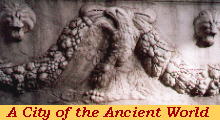 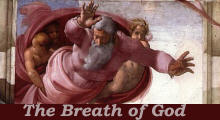
|







